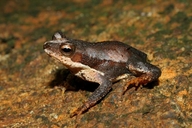|
Description
Bufo longinasus is distinctive because its lack of cranial bony ridges. The first finger is shorter than the second, and B. longinasus has fully webbed toes that are slightly swollen. The average snout to vent length is 25.5 mm. It is 35 mm including vent to hind limb toe tip. The head and body are relatively flat and compressed, with a projecting cone shaped nose and nostrils at the tip. The tympanum is very small, roughly half the diameter of the eye. Parotoid glands are large. Brown nuptial pads are present on top and side of the basal area of the fingers. The skin is smooth on the dorsal surface, with distinct pitted pustules, but it is not rugged. The species is ventrally wrinkled on breast and belly and the undersides of hind limbs are rough and granulated (Barbour and Ramsden 1919).
Coloration: The ground color is dark maroon, with white coloration present on the upper lip, above the arm, and half of the ventral surface of the hands and feet (Barbour and Ramsden, 1919).
Distribution and Habitat
Country distribution from AmphibiaWeb's database: Cuba
B. longinasus is endemic to Cuba and is found in three very small areas: Pinar del Rio Province, Sierra de Trinidad, and Sierra del Guaso. It occurs in upland pinewoods and broadleaf forests near streams from 100-820 m above sea level. (Stuart et al, 2008)Life History, Abundance, Activity, and Special Behaviors
B. longinasus is terrestrial by day and may be arboreal by night. Males call while floating in water, which is also where eggs are laid and larvae develop. (Stuart et al. 2008) Trends and Threats
The current population of B. longinasus is decreasing. They are declared an endangered species, occupying less than 500 km2 of its native habitat (Hedges & Diaz 2004). Population threats include clear-cutting and subsistence logging, causing a decrease in upland forest habitat. It is also threatened by habitat fragmentation and disturbance. Subsistence farming, fires and agricultural expansion also contribute to habitat loss and thus to this species' decline. Its range does include several protected areas, but lacks proper management. (Stuart et al. 2008)
In 2006, Batrachochytrium dendrobatidis, a chytrid fungus that causes the disease chytridiomycosis in amphibians, was first observed in the subspecies, B. longinasus dunni. This was the first known case of chytridiomycosis in Cuba, threatening all four local subspecies of B. longinasus (Diaz et al. 2007). Possible reasons for amphibian decline Habitat modification from deforestation, or logging related activities
Habitat fragmentation
Comments
Etymology: The word Bufo translates to toad in Latin, and nasus translates to nose in Latin; making Bufo longinaus the long-nose toad.
Synonymy/taxonomy: This species has gone through several taxonomic revisions in the genus Bufo and has also been placed in Peltophryne (Frost et al. 2011). It is currently synonymous with the name P. longinasus (Hedges and Diaz 2004 ; Frost et al. 2011).
References
Barbour, T., and Ramsden, C. T. (1999). The Herpetology of Cuba. Biolife, Cambridge.
Díaz, L. M., Cádiz, A., Chong, A., and Silva, A. (2007). ''First report of chytridiomycosis in a dying toad (Anura: Bufonidae) from Cuba: A new conservation challenge for the island.'' Ecohealth, 4(2), 172-175.
Frost, D. (2011). Amphibian Species of the World: an Online Reference. Version 5.5.
Hedges, B., Díaz, L. (2004). ''Peltophryne longinasus''. IUCN (2011). 2011 IUCN Red List of Threatened Species. www.iucnredlist.org. Downloaded on 18 October 2011.
Stuart, S., Hoffmann, M., Chanson, J., Cox, N., Berridge, R., Ramani, P., Young, B. (eds) (2008). Threatened Amphibians of the World. Lynx Edicions, IUCN, and Conservation International, Barcelona, Spain; Gland, Switzerland; and Arlington, Virginia, USA.
Originally submitted by: Jenna Coates (first posted 2011-06-23)
Edited by: Kandys Kim, Michelle S. Koo (2023-03-15)Species Account Citation: AmphibiaWeb 2023 Peltophryne longinasus: Western Cuba Long-nosed Toad <https://amphibiaweb.org/species/405> University of California, Berkeley, CA, USA. Accessed May 8, 2025.
Feedback or comments about this page.
Citation: AmphibiaWeb. 2025. <https://amphibiaweb.org> University of California, Berkeley, CA, USA. Accessed 8 May 2025.
AmphibiaWeb's policy on data use.
|
